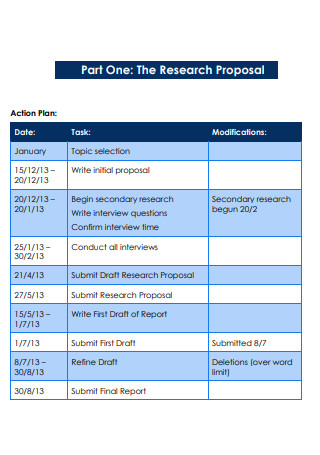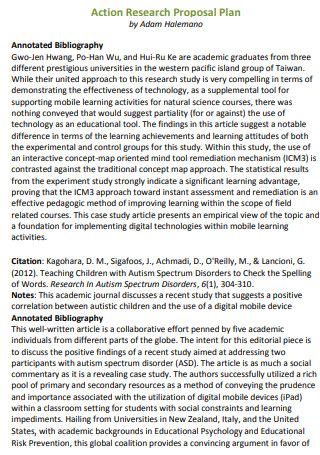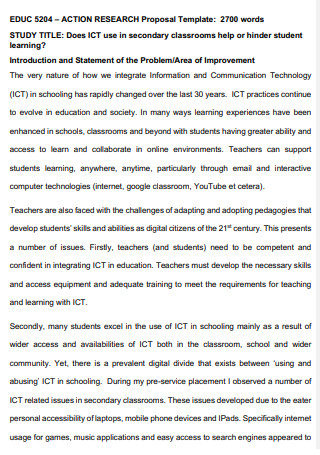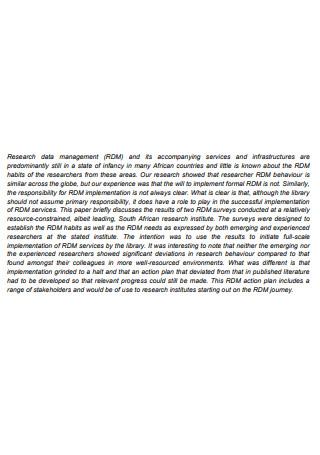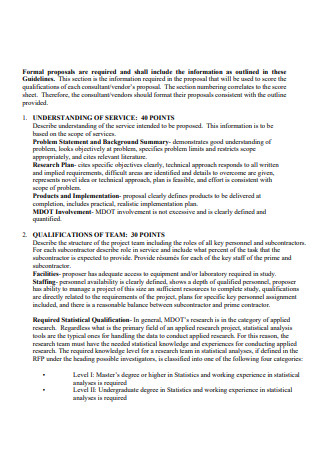4+ SAMPLE Research Proposal Action Plan
FREE Research Proposal Action Plan s to Download
4+ SAMPLE Research Proposal Action Plan
What is a Research Proposal Action Plan?
Different Types of Research Designs
Basic Components of a Research Proposal Action Plan
How to Write a Research Proposal Action Plan
FAQs
What are the benefits of a research proposal action plan?
What are the basic components of a research proposal action plan?
What are some examples of research designs?
How to manage and monitor a research proposal action plan?
What is a Research Proposal Action Plan?
A research proposal action plan is a clear and effective document which is generally used to acquire a thesis, or get approval for a dissertation plan. It also clearly demonstrates valuable interpretations of new ideas and concepts on a specific research project in a logical manner. It is also a strategic planning tool with the purpose of guiding the key professionals who are involved in a business or organization to facilitate systematic planning when reaching further development and success. Also, it is crucial to be included in one’s overall research and development plan.
According to a 2019 statistical study, EU Research and development expenditure relative to GDP stood at 2.23% in 2019, at the same level as China (2.23%) but lower than South Korea (4.64 %), Japan (3.20 %) and the United States (3.08 %). In order to increase the stock of knowledge and to devise new applications of available knowledge, research and development (R&D) is executed along with activities aimed at obtaining new knowledge or understanding without specific immediate commercial applications or uses, activities aimed at solving a certain issue or attaining a particular commercial objective, and systematic work which draws on research and practical experience. Thus, all kinds of college and university students and working professionals like academic researchers, market researchers, biological researchers, project managers, team supervisors, teachers, medical professionals, and business owners should effectively create a compelling and well-detailed research proposal action plan.
Different Types of Research Designs
Research design is all about formulating crucial decisions. To formulate meaningful choices about research design, students and professionals need to know both what their options are and how to evaluate those options. Effective research design is equally about why you are doing your research and how you will do it. So, developing decisions about research design requires conscious attention to both the purposes behind your research and the procedures you use to address those purposes. Additionally, you should have clear insight about the different types of research designs that you will utilize for your research and development matters. Here we will explain to you about the different types of research designs below:
1. Descriptive Research Design
According to the book Design and Analysis for Quantitative Research in Music Education, the primary tasks of music education researchers that they need to undertake are observation and description. In the field of music, there exists immense complexity and variety in the music teaching and learning business. The systematic acquisition of information for the purpose of observing and documenting variation in some phenomena as it naturally exists is the core of what could be commonly referred as descriptive research.
The significance and value of descriptive research lies in the necessity of having a clear enough understanding of a phenomenon of interest to aid in theorizing about it. Maintaining such knowledge and insight will eventually lead to clearer theoretical propositions, operational definitions, research questions, and hypotheses. Thus, descriptive research design is most commonly an exploration of what is, what exists, and/or the status of any given topic of interest. Descriptive studies are often undertaken with an inductive motive for accumulating a knowledge base that could inform theory development, suggest possible relationships among variables to explore attitudes, beliefs, behaviors, demographic characteristics, and/or lead to experimental hypotheses to be tested in the future.
2. Correlational Research Design
Also known as observational or nonexperimental research design, the correlational research design is a type of research design when the researcher does not intervene or use experimental control methods such as elimination, manipulation, inclusion, group or condition assignment. An Applied Guide to Research Designs explained that several investigators and researchers use this research design and approach when they are interested in measuring the degree of association like relationship between variables or to predict some outcome according to the predictor variables. Statistical procedures and techniques are the only type of control that can be used for correlational research design.
Researchers can measure the strength or magnitude and direction of the relationship between variables or predict the influence one variable has on another. They can also apply analysis to observational data that compares the mean differences of varied groups. Several researchers prefer to use the word explanation instead of prediction. For instance, if a phenomenon can be explained, then it can be predicted, although a prediction does not infer explanation. Results from the observational data in this type of research design oftentimes can provide a strong case for developing causal inferences. But, scientists should be careful when formulating causal inferences according to the observational data. So, an essential aspect to consider for the correlational research design is the sample size and correlational inference.
3. Experimental Research Design
The significance of experimentation has steadily grown within design research over the last 20 years. For example, a 2015 report revealed that just 2% of papers in Design Studies dealt with experiments, while in 2014, that number was 24%. So, experimental research design in its multi-faceted forms is increasingly recognized as a powerful means for accomplishing design research. Still, this brings increasing demands in terms of how and where experimental techniques can be executed, methodological rigor, and the generation of scientific knowledge. In experimental research design, the development of experimentation is intrinsically connected with the development of technology development.
Experimental methods formed on technologies and technical insights while simultaneously contributing to technological innovations and technical understanding. That’s why there are a number of parallels between the realization of experimental processes and those processes of technological development that often create the focus of research design. This is specifically essential in the social and human sciences such as economics, sociology, medicine, and psychology, where experimental activities create a valuable part of the greater scientific endeavour.
4. Diagnostic Research Design
If you are working on looking for associations or specifically trying to conclude with findings that form relationships, diagnostic research design is a type of research design when one aspect exists and has led to another aspect. Some common examples for association can be the research findings in supermarket shopping, a study of setting associations about people who prefer to buy butter along with bread or even associations of buying eggs along with milk, a study involving mining associations and many more. In this type of research design, it is fundamental to carefully work on this research design as it is necessary to collect data samples that suit or are belonging to the category of association the researchers are trying to explore.
So, the research design needs to accommodate and conduct changes as per the type of research. In diagnostic research design, the sample design should be prepared to precisely obtain the data set required for the study. A wide-ranging of researchers would be keen on applying the different sampling techniques including cross-fold, random or any other techniques.
5. Explanatory Research Design
Are you studying as to why the majority of students are keen in pursuing an accounting degree despite several other avenues? This type of research design assesses the “Why” questions. The question before modifies the way in which data collection happens. While creating the research design, comprehensive or detailed data collection for the problem at hand should be executed. Researchers need to have a clear understanding about causal relationships in order to address the question of why. Also, it is integral to determine the impacts and effects of one attribute with another that is involved in the research.
Basic Components of a Research Proposal Action Plan
In this section, you will learn how to construct a well-written and systematic research proposal action plan. However, a research proposal action plan has different kinds of components. Include the following elements for you to create a professional piece of writing:
How to Write a Research Proposal Action Plan
A research proposal Action Plan should cover the most integral information concerning the well-rounded elements of your business firm, institution, or organization. Check and ensure that you structure your research proposal action plan in sections. When you prepare an action plan, it should be organized and systematic along the strategic planning goals and objectives, desired outcomes, and outcomes which will be accomplished. Below are some easy-to-follow tips that indicate how to write a clear and structured research proposal action plan:
-
Step 1: Define Clear Goals and Strategic Objectives
What are your clear research Goals and objectives? Think carefully about the things you want to achieve in your research work or action research projects. Also, understand and manage possible changes and adopt an optimistic attitude so that you are able to improve the chances of successful implementation of the strategy. Clearly identify the areas to be improved and make sure that you define a logical set of desired goals and strategic objectives.
-
Step 2: Prepare a List of the Action Research Plan Methods and Procedures
The second step is listing down the essential steps or the methods and procedures for your research proposal action plan. The elements should demonstrate clarity and must be easy to follow. Ensure that you include the fundamental methods in carrying out the action plan and outline them in a systematic manner. In this way, you are able to accomplish your overall action plan in your research work.
-
Step 3: Add the Literature Review
After defining your research goals and objectives and indicating the action research plan methods and procedures, include the literature review of the books, scholarly articles and other academic sources that you used in carrying out the research proposal action plan.
-
Step 4: Write an Evaluation and End with a Conclusion
Write a careful Evaluation during the action research planning process. So, observe carefully on what is working and what is not working. Establish an effective process for review and measuring successes, challenges and growth opportunities. Then, end your research proposal action plan with a simple conclusion.
-
Step 5: Proofread and Prepare the Overall Plan
Review your entire research proposal Action plan and make sure that you fully present all the core points in your action plan. It should display the connection between the action research goals, objectives, resources, strategies and methods, activities used for attaining the objectives, and the evaluation of the people involved in the action research plan. If you realize that you overlook some sections that need more elements, it is important to edit and revise the document as soon as possible.
FAQs
What are the benefits of a research proposal action plan?
Facilitating critical thinking, logical analysis, and reflection, providing clarity and focus in reaching definite research goals and strategic planning objectives, establishing ownership and accountability, and determining measures of success are the benefits of a research proposal action plan.
What are the basic components of a research proposal action plan?
The basic components that should be included in a research proposal action plan are abstract, introduction, problem statement and research questions, literature review, research plan, conclusion, and references.
What are some examples of research designs?
Some examples of research designs are descriptive research design, correlational research design, experimental research design, diagnostic research design, explanatory research design, exploratory research design, and hypotheses-based research design, and more.
How to manage and monitor a research proposal action plan?
If you need to manage and monitor a research proposal action plan, you need to define the research goals and objectives, regulate indicators, data collection methods, and timeline, and look for the proper roles and responsibilities of key individuals in your research and development team.
In order to properly carry out the research work, you need to prepare a compelling proposal as it serves as the action plan to execute your work. Therefore, writing a clear and systematic research proposal action plan will guide you and many other professionals in promoting better development and growth while realizing the vision and success in the research and development field. We learned in this article about different types of research designs and how specific the action plan in the research proposal is, will vary across the different research styles. Writing a highly pre-structured research action plan through forming the basis for the remainder of the research process is the most crucial part of the overall process. To assist you in research proposal action plan writing, you can learn and apply the tips aforementioned in this article. Plus, we have included several research proposal action plan samples, sample business plan templates, presentation templates, project proposal templates, business proposal samples, research proposal templates, and other strategic planning templates that you can download.

